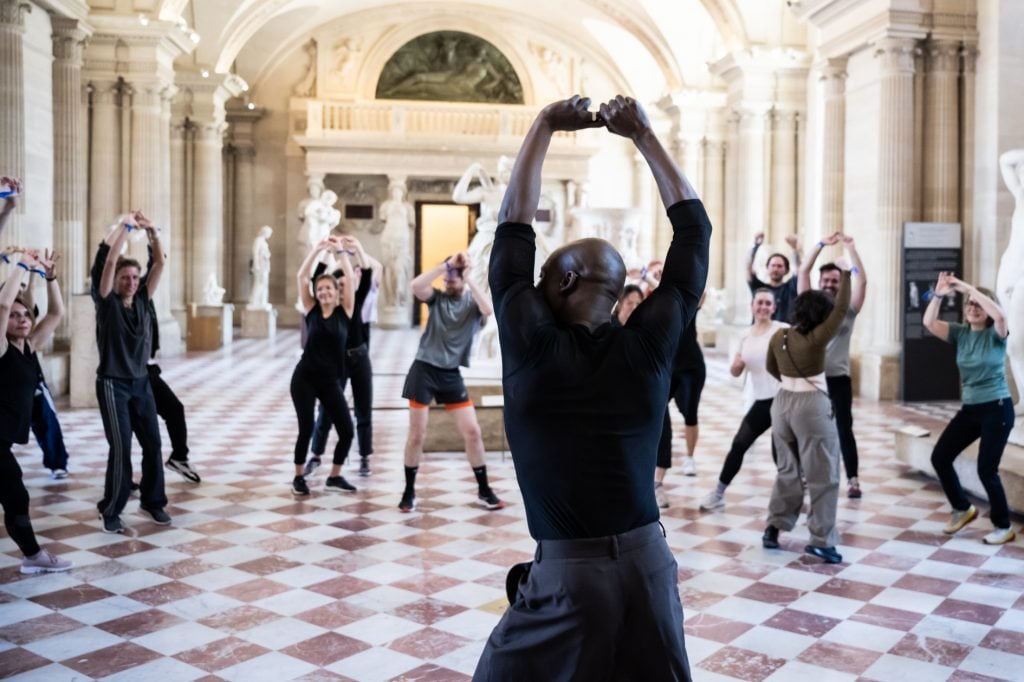This spring, art lovers in Paris had the rare chance to participate in an early morning workout at the Louvre, enjoying yoga and dance moves while running through the galleries of the famed institution. It isn’t the first time a museum has gotten into the fitness game, but now a New York dance outfit, Monica Bill Barnes and Company, has accused the Louvre of copying the Museum Workout, its popular program that debuted at New York’s Metropolitan Museum of Art in 2017.
Robbie Saenz de Viteri, the company’s artistic director, only learned about the similarities between the Louvre’s offering and his own work when a friend reached out to congratulate him about bringing the Museum Workout to the Louvre.
“We were shocked, completely shocked,” Robbie Saenz de Viteri, the company’s artistic director, told me in an email about when he first read of the Louvre’s project in the New York Times. “We were seeing an element of our personalities that we channel into our work represented without any trace of our names or voices. It was surreal.”
In New York, the Museum Workout was a commission from Met Live Arts and an immediate hit. Its sold-out run of 16 performances in January 2017 was extended for the full year. It has since traveled to institutions including the Philadelphia Museum of Art and the National Gallery of Victoria in Melbourne, Australia.
The Museum Workout at the Metropolitan Museum of Art. Photo: Paula Lobo, courtesy Monica Bill Barnes & Company.
But the Louvre never contacted Saenz de Viteri or Monica Bill Barnes about staging a similar event in its own halls. Instead, the museum enlisted French choreographer Mehdi Kerkouche to design an athletic route through its galleries that it dubbed Courez au Louvre, or Run in the Louvre.
In a blog post on the company website, Saenz de Viteri described some of the similarities between the two projects, both held in the early morning before visiting hours. The Louvre routine kicked off with Michael Jackson’s song “Don’t Stop ’til You Get Enough,” which started the Museum Workout experience in Melbourne. And both ended with participants lying on their backs in the shavasana pose beneath a glass ceiling.
Saenz de Viteri reached out to the Louvre to ask if the Museum Workout had been an inspiration for Run in the Louvre.
“We had told our colleagues at the Met that we were designing a program for the Louvre. They generously shared their experience in the logistic and practical areas,” Luc Bouniol-Laffont, the Louvre’s director of performing arts told Saenz de Viteri in an email that I reviewed. (As of press time, neither the Louvre, the Met, nor Kerkouche had responded to my inquiries.)

“Run the Louvre” in the Salle des Cariatides at the Louvre. Photo courtesy the Louvre.
But the Louvre, which wanted to expand its three-year-old yoga program to include cardio and dancing, didn’t consider tapping the New York dance company for the job.
“Naturally we wanted to work with a French choreographer,” Bouniol-Laffont wrote. “A project like Courez au Louvre requires months of preparation in advance, numerous meetings on site with the museum teams, the curators etc. and the continued presence of the artists for six weeks for rehearsals and a long run of performances. For obvious practical, financial, and also environmental reasons, we could only achieve this project with a Paris-based choreographer and a Paris-based company.”
The email exchange confirmed Saenz de Viteri’s gut feeling that Run in the Louvre was inspired by the Museum Workout, but didn’t provide much comfort.
“The eerie feeling shifted to something more acutely painful,” he said. “Not only did we lose a potential source of income on a job, but we lost the recognition of our own ideas and it’s hard to quantify the potential of that.”
Follow Artnet News on Facebook:
Want to stay ahead of the art world? Subscribe to our newsletter to get the breaking news, eye-opening interviews, and incisive critical takes that drive the conversation forward.


